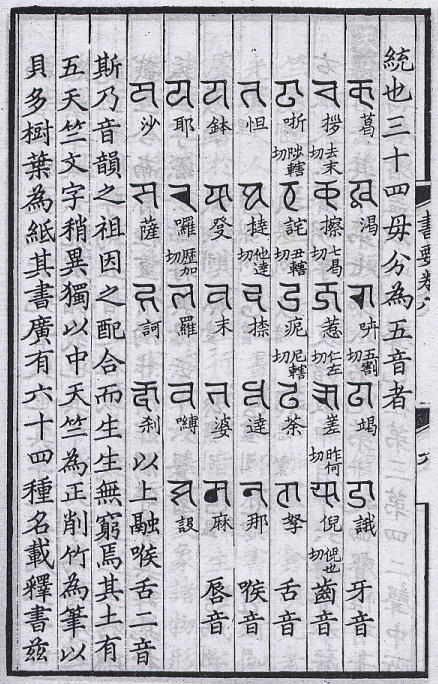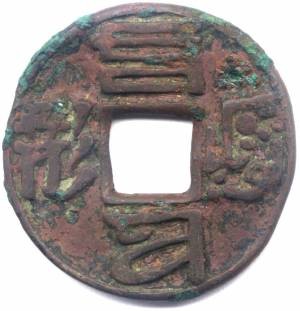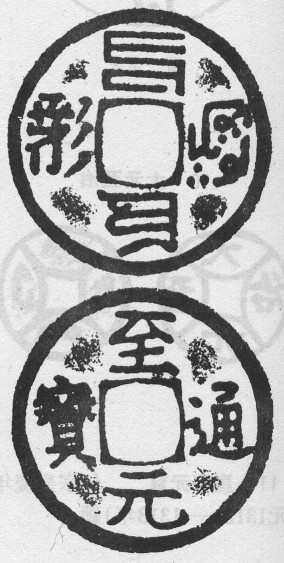BabelStone Blog
Wednesday, 10 January 2007
Zhida Tongbao
This is probably my favourite Yuan dynasty coin, a rare special issue that has an obverse inscription in four different scripts. This particular example, with twin phoenixes on the reverse, sold in China recently for RMB 55,000 (nearly USD 7,000) [another example].
It is also quite an enigmatic coin, with different sources providing different explanations of the scripts and their meaning. In the auction catalogue of this coin it is described as being inscribed with a transcription of the standard coin formula Zhizhi Tongbao 至治通寶, i.e. cash coin of the Zhizhi period (1321-1323), reading top-to-bottom and right-to-left. This is the most common interpretation, but the inscription has also been interpretted as reading Zhiyuan Tongbao 至元通寶, i.e. cash coin of the Zhiyuan period (1264-1294 or 1335-1340), because some examples of this coin do have the inscription Zhiyuan Tongbao 至元通寶 in Chinese characters on the reverse. It is also less commonly interpretted as reading Zhida Tongbao 至大通寶, i.e. cash coin of the Zhida period (1308-1311). Everyone is agreed on three of the words, but the bottom character causes much confusion, with its script variously described as being Phags-pa, Tibetan, Uighur-Mongolian or Khitan. I don't think it is any of these scripts, and I think that the reading Zhida Tongbao 至大通寶 is the correct one.
Zhi 至
The top word is not problematic. It is clearly written in the Phags-pa script, and reads ji ꡆꡞ, corresponding to Chinese zhi 至.
Da 大
For a long time I was stumped by the word at the bottom of the coin, but then recently I looked again at the table of Sanskrit letters given by Tao Zongyi 陶宗儀 in his work on scripts and calligraphy, Shushi Huiyao 書史會要 (mid 14th century, but based on an earlier work), and it was obvious that the letter was in fact a corruption of the letter tha in the Lantsa script.

If you look at the 2nd letter down in the 4th column from the right you can see the letter tha, with the Chinese phonetic gloss of tà 撻. This is clearly the same letter as on the coin, but on the coin the top loop of the letter is incorrectly written so it does not join up. The letter tha is not the expected transcription of Yuan dynasty Chinese da 大, which is written tay ꡈꡗ in Phags-pa, but was perhaps close enough for someone who was not skilled in Sanskrit pronunciation
In fairness, I have to add that in the examples of this coin with Zhiyuan Tongbao 至元通寶 in Chinese characters on the reverse, the letter on the bottom has an additional horizontal stroke not seen in this example, but I think that that must be a later, further corruption of the unfamiliar letter.
Tong 通
The word on the right is apparently a transcription of tong 通 in the Uighur Arabic script (also known as Chaghatayid script), but unfortunately I have absolutely no reading knowledge of Arabic at all, so I don't know how exactly tong is transcribed. If anyone can provide a Unicode transcription of the word on the coin I would be very grateful.
Bao 寶
The word on the left is the Tangut character 𘜑 (Xiahan Zidian #0999, Wenhai Yanjiu #4718).
In the 14th century Tangut "Sea of Characters" 文海 dictionary this character is glossed as meaning "wave" (Chinese bo 波), and Li Fanwen gives the character a reconstructed pronunciation of pa in his Tangut dictionary, so presumably this is a phonetic borrowing intended to represent Chinese bao 寶. Oddly enough this is not the Tangut character used for bao 寶 in Western Xia coins with a Tangut inscription (𘏨).
Last modified: 2017-01-01 (updated with Unicode Tangut characters)
If Tangut characters do not display correctly, please download and install the Tangut Yinchuan font.
Numismatics | Phags-pa | Tangut
Index of BabelStone Blog Posts

